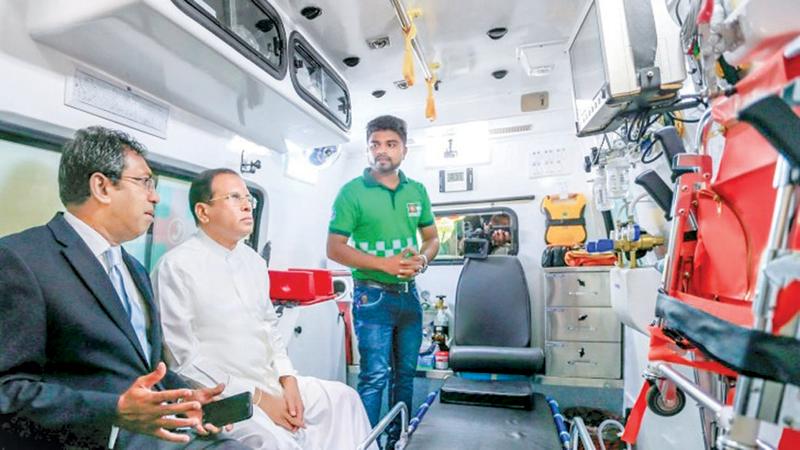
In a letter sent to the Director-General of Health Services, Dr Anil Jasinghe, last Monday (26) , the Government Medical Officers Association (GMOA) had critically questioned the standard of the famed Suwaseriya ambulance service, which serves Sri Lankans free of charge.
The GMOA had questioned the following in this letter; the recruitment criteria of ambulance service staff, posts they held within the Ministry of Health, the supervisory and monitoring mechanism of employees of the ambulance service, standards and details of the training they receive, what are the opportunities for them to have in-service training, whether they are registered within SLMC as para-medical staff, and whether they are allowed to prescribe medicine to patients and if so what are the drugs and who decides what drugs to prescribe.
The Suwaseriya ambulance service was initially attached to the Ministry of Health. However, in the recent cabinet reshuffle and a gazette issued later handed over the Suwaseriya Foundation to the Ministry of Economic Reforms and Public Distribution, where Dr Harsha De Silva, the man behind Suwaseriya is the Subject Minister.
GMOA letter
Interestingly, the GMOA had copied their letter, to the Secretary of the Ministry of Health, all heads of health institutions, Registrar to the Sri Lanka Medical Council and all GMOA branch unions but had not copied it to the Subject Minister or the Secretary of the Ministry.
However, when contacted, the Subject Minister Dr Harsha De Silva refused to comment about the letter. “I do not want to comment about this as the letter did not reach me. Also, I have nothing to comment about this as the public knows the truth”, he said.
The Suwaseriya ambulance service or rather the 1990 ambulance service as its popular among the public, started its operations on July 2016, initially covering Western and Southern Provinces. The service began with 88 ambulances donated by the Government of India to Sri Lanka now has a fleet of 297 state-of-the-art ambulances. The main target of the service was to reach patients in a few minutes (Current average reach time is 11.4 minutes) and to provide pre-hospital medical care while patients are being taken to the nearest government hospital.
At present, the service covers all nine provinces providing about 1,500 employment opportunities for youth. As reported these employees are given training in foreign countries too. As revealed at the small ceremony organised to mark the third anniversary of the free ambulance service, it has so far hospitalised more than 200,000 patients, island-wide which number includes 97 childbirths too.
EMTs
To facilitate this operation, Emergency Medical Technologists receive basic training at the Gandhi Memorial Hospital and the GVK Emergency Management and Research Institute in India. In addition to that drivers are also trained in first-aid and tactful driving skills in Sri Lanka.
Contrary to this reality, the powerful doctors’ trade union threatened at the beginning of the Suwaseriya ambulance service, not to even accept patients brought into hospitals by Suwaseriya ambulances.
A senior female officer attached to the National Hospital on the basis of anonymity told the Sunday Observer that the Suwaseriya service currently makes an immense contribution to the health sector. “In our perspective what matters is not their facilities, but how fast they bring patients to hospitals.
“In that way, they are doing a pretty good job. For instance, currently, about 50 per cent of the accident ward entries are done through Suwaseriya”, she explained.
“Even ambulances in government hospitals do have shortcomings. In that case, if we abandon Suwaseriya, it would be an irreplaceable loss to the health sector”, she stressed.
Revolutionary step
The Suwaseriya service was a revolutionary step forward in Sri Lanka’s free health care system. Before Suwaseriya only an affordable community sought the aid of an ambulance service when hospitalising patients. Ambulances owned by government hospitals were only used to transfer patients from one hospital to another and not to bring patients from the place of accident. Therefore, the Suwaseriya was more of a service for everyone in the society irrespective of the size of their pocket.
(Despite several attempts to contact, Dr Anil Jasinghe was not available for comment)
